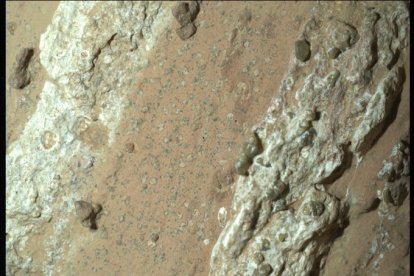Mars: NASA's Perseverance finds a rock that could contain ancient microscopic life
The space agency's rover collected samples of the rock which, scientists explained in a statement, will be returned to Earth in the coming years to determine whether organisms capable of surviving billions of years ago existed on the Red Planet.

Image of the rock that could contain ancient microscopic life found by the Perseverance rover on Mars.
NASA continues to investigate whether there was life on Mars and this Thursday may have made the most surprising discovery in this investigation.
Which is that the rover Perseverance, belonging to the space agency, may have found a rock that might contain microscopic ancient life on the Red Planet.
As reported by NASA, the six-wheeled robotic explorer found an enigmatic rock shaped like an arrow. Named "Cheyava Falls," this rock could harbor fossilized microbes from billions of years ago when the Red Planet was a watery world.
However, the find was not made on Thursday, July 25. It was four days earlier, on July 21. On that day, NASA reported, Perseverance drilled into the rock to collect a core sample. The specimens were carefully stored on the underside of the rover, with the goal of sending them to Earth so scientists can perform a more thorough analysis.
One of the researchers who will thoroughly study the samples will be project scientist Ken Farley. Belonging to Caltech, the researcher explained, in statements published on the NASA website, what the finding of this rock entails:
"Cheyava Falls is the most puzzling, complex, and potentially important rock yet investigated by Perseverance."
His enthusiasm is justified. As the news agency was able to find out, there are three clues that could indicate that there is indeed ancient microscopic life in the rock.
First, there is the fact that there are white streaks of calcium sulfate running through the rock. This would mean that water flowed through it at one point.
Not only that, in addition to the white streaks, between the cracks a reddish central zone was found, full of organic compounds, as detected by the SHERLOC (Scanning Habitable Environments with Raman and Luminescence for Organic and Chemical Substances) instrument that is installed on Perseverance.
Finally, a result from the PIXL (Planetary Instrument for X-ray Lithochemistry) scanner found small leopard-like spots containing chemicals that could indicate the presence of ancient microbial energy sources.
Features that could demonstrate the existence of ancient microscopic life, explained astrobiologist and member of the Perseverance science team at Queensland University of Technology in Australia, David Flannery:
"On Earth, these types of features in rocks are often associated with the fossilized record of microbes living in the subsurface."
A process yet to be determined
Although the indications are good, the scientists warn that the process to confirm that there was life on Mars is still inconclusive and that, in fact, it is far from over.
As explained by the scientists, it will not be possible to confirm whether life existed on Mars until samples of the rock travel to Earth as part of the Mars Sample Return Program, a collaboration between NASA and the European Space Agency planned for the 2030s whose investigation would confirm the surprising finding.
Moreover, AFP reports, even if these findings turn out not to be ancient microscopic life, there is a second possibility: that they are actual fossilized microbes.
This, Farley explained, would be more interesting, since it would represent the first evidence of off-Earth life in history and, as such, has been the subject of study in every possible way while still in space:
"We have zapped that rock with lasers and X-rays and imaged it literally day and night from just about every angle imaginable."
However, he reminded, for the moment this is only conjecture, since research cannot continue until the samples are on Earth: "Scientifically, Perseverance has nothing more to give. To fully understand what really happened in that Martian river valley at Jezero Crater billions of years ago, we’d want to bring the Cheyava Falls sample back to Earth, so it can be studied with the powerful instruments available in laboratories," explained Farley before the conclusion of the appearance organized by NASA on this important discovery.
RECOMMENDATION





















